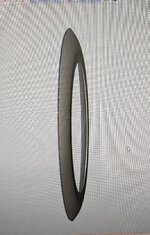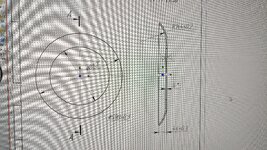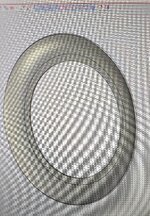Navigation
Install the app
How to install the app on iOS
Follow along with the video below to see how to install our site as a web app on your home screen.
Note: This feature may not be available in some browsers.
More options
Style variation
-
Congratulations JStephen on being selected by the Eng-Tips community for having the most helpful posts in the forums last week. Way to Go!
You are using an out of date browser. It may not display this or other websites correctly.
You should upgrade or use an alternative browser.
You should upgrade or use an alternative browser.
How can such a part be made from steel?
- Thread starter Mr_Curious
- Start date
- Status
- Not open for further replies.
GregLocock
Automotive
"If make it from segments and then weld, then maybe it will make it easier to manufacture?"
No, that would be a path to disaster. Spin it and then maybe finish grind if your tolerances are real.
No, that would be a path to disaster. Spin it and then maybe finish grind if your tolerances are real.
Christine74
Mechanical
I think this part would be called a Dished & Internally Flared head. Very similar to a Flanged Only head. I've never seen one before, but there are several manufacturers that make Flanged Only/Dished & (externally) Flared heads in this size/thickness range.
-Christine
-Christine
Last edited:
GregLocock
Automotive
Such a shallow shape is prone to Pretzelling or Pringleing, that is why I am dubious about your tolerances. The good news is that when you fasten it to whatever else the thing will happily deform to comply. If you actually need it not to pretzel/pringle then you need some ridges, look at a steel wheel as an example.
(Christine it is about the size of the end of a small railway engine with the big domed door used for cleaning the tubes, called the smokebox door)
(Christine it is about the size of the end of a small railway engine with the big domed door used for cleaning the tubes, called the smokebox door)
- Thread starter
- #24
Mr_Curious
Mechanical
This is buyis this a buy or is this an experiment
GregLocock
Automotive
That's a new one on me. Not the idea of bashing flat plate into curved shapes, but that machine. Another option would be an English wheel.
"Steel" means not very much. If it needs to be maraging or heat treated alloy steel that could be quite messy.
If it's a ductile low carbon steel like A-36 then the spinning and forming options could make sense. I think the overall strategy is to take a piece of cut plate and form the curvature, maybe do a finish cut on the OD and/or ID.
Work hard on expanding your tolerances. If there is tooling involved the vendor could spend a lot of (your) money on adjusting the tooling to hit the middle of the tolerance range every time and not scrap parts. Same with spinning - works great in small quantities but if your tolerances are tight they may need to do it a few times.
Agree that any machining or welding process could cause h*ll on this or require expensive fixtures to control distortion.
If it's a ductile low carbon steel like A-36 then the spinning and forming options could make sense. I think the overall strategy is to take a piece of cut plate and form the curvature, maybe do a finish cut on the OD and/or ID.
Work hard on expanding your tolerances. If there is tooling involved the vendor could spend a lot of (your) money on adjusting the tooling to hit the middle of the tolerance range every time and not scrap parts. Same with spinning - works great in small quantities but if your tolerances are tight they may need to do it a few times.
Agree that any machining or welding process could cause h*ll on this or require expensive fixtures to control distortion.
- Status
- Not open for further replies.
Similar threads
- Question
- Replies
- 21
- Views
- 12K
- Question
- Replies
- 12
- Views
- 2K
- Question
- Replies
- 9
- Views
- 943
- Locked
- Question
- Replies
- 3
- Views
- 2K
- Locked
- Question
- Replies
- 15
- Views
- 9K



